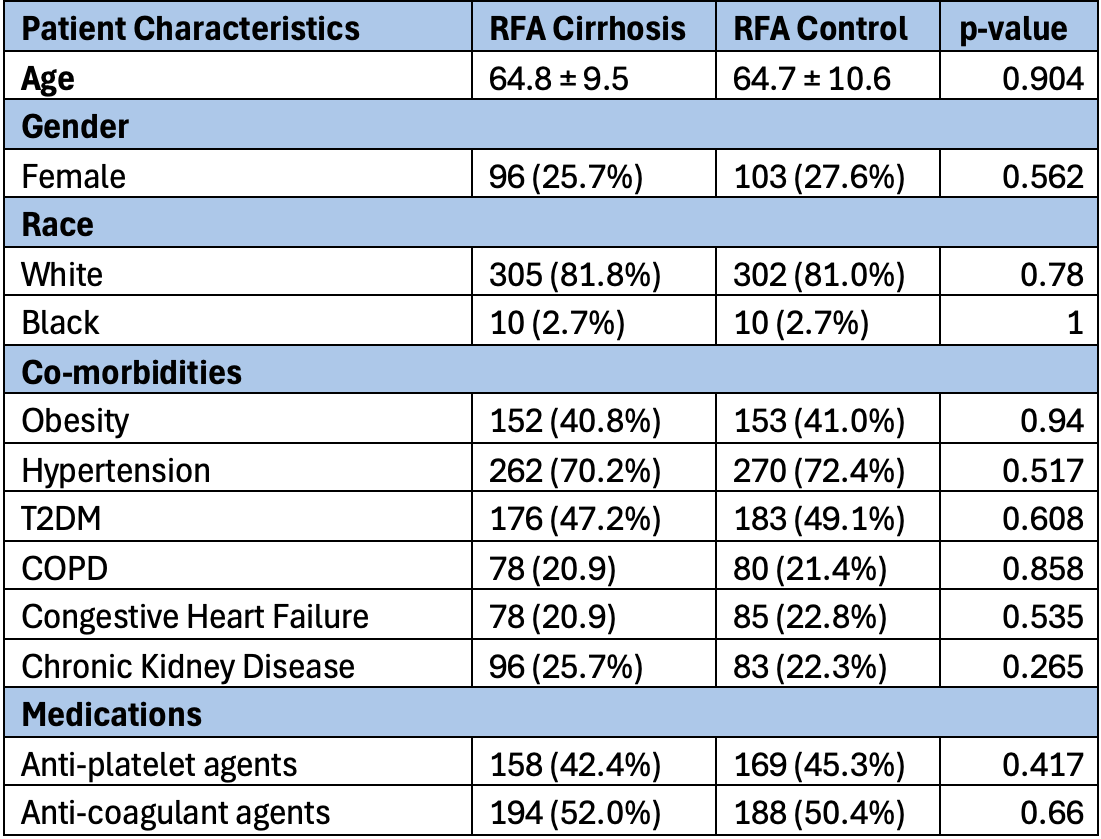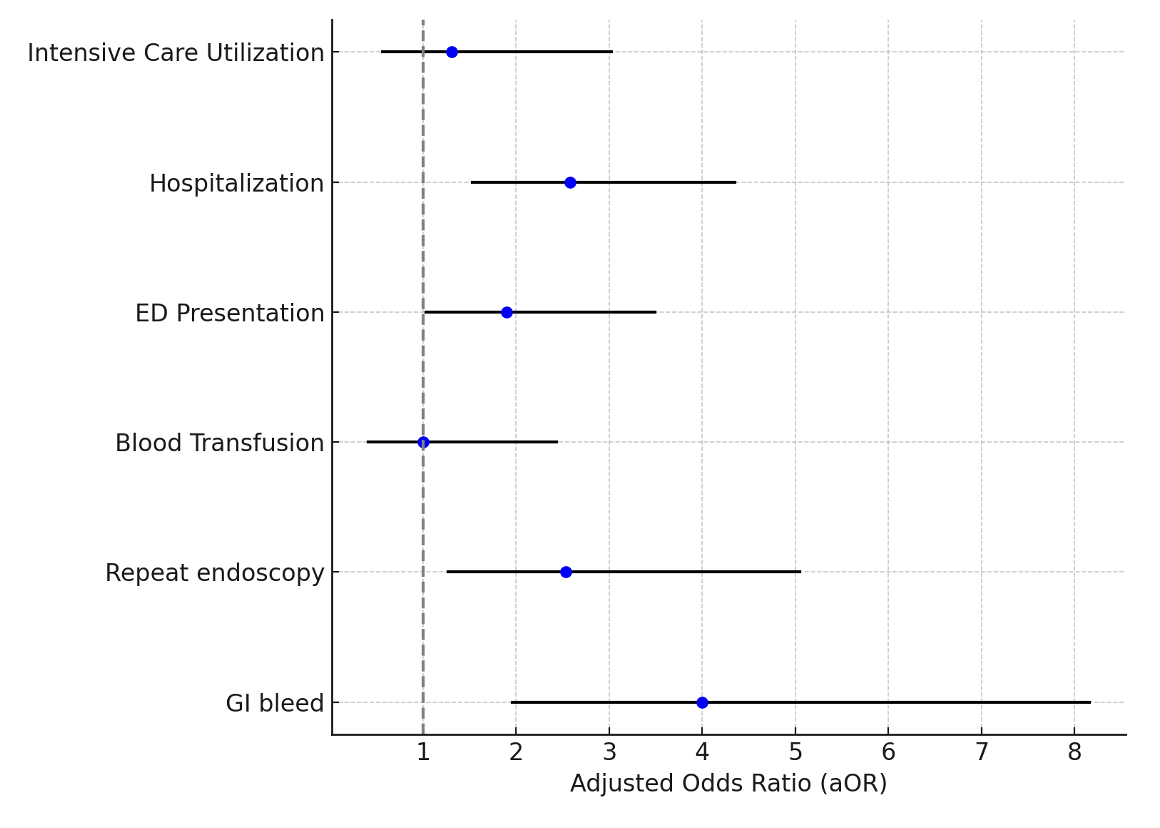Monday Poster Session
Category: Esophagus
P2799 - Safety Outcomes of Radiofrequency Ablation for Barrett's Esophagus in Patients With Cirrhosis Versus Non-Cirrhotic Controls: A Propensity-Matched Analysis
Monday, October 27, 2025
10:30 AM - 4:00 PM PDT
Location: Exhibit Hall
- AP
Abhishek Patel, MD (he/him/his)
University of New Mexico
Albuquerque, NM
Presenting Author(s)
Abhishek Patel, MD, Ahmed Telbany, MD, Archish Kataria, MD, Evelyn Inga, MD, Pooja Viswanath, DO, Gulshan Parasher, MD, FACG
University of New Mexico, Albuquerque, NM
Introduction: Radiofrequency ablation (RFA) is a standard treatment for Barrett's esophagus. However, its safety profile and resource utilization in patients with cirrhosis, who may be at higher risk for complications, remains poorly characterized.
Methods: Using a large healthcare database, we conducted a propensity score-matched analysis comparing 30-day outcomes between BE patients with cirrhosis (n=373) and without cirrhosis (n=373) undergoing RFA. Primary outcomes included post-procedure adverse events and healthcare resource utilization.
Results: Baseline characteristics were well-matched between cirrhotic and non-cirrhotic groups, including age (64.8±9.5 vs 64.7±10.6 years, p=0.904), gender distribution (25.7% vs 27.6% female, p=0.562), and comorbidities such as hypertension (70.2% vs 72.4%, p=0.517) and diabetes (47.2% vs 49.1%, p=0.608) [Table 1]. At 30 days, cirrhotic patients demonstrated significantly higher rates of gastrointestinal bleeding (aOR 3.997, 95% CI 1.957-8.164, p< 0.0001) and need for repeat endoscopy (aOR 2.536, 95% CI 1.274-5.05, p=0.006). Healthcare utilization was also increased in the cirrhotic group, with higher rates of emergency department presentations (aOR 1.898, 95% CI 1.032-3.493, p=0.0367) and hospitalizations (aOR 2.585, 95% CI 1.535-4.351, p=0.0002). However, there were no significant differences in blood transfusion requirements (aOR 1.0, 95% CI 0.411-2.432, p=1.0) or intensive care utilization (aOR 1.311, 95% CI 0.567-3.028, p=0.5252) [Figure 1].
Discussion: Patients with cirrhosis undergoing RFA for Barrett's esophagus experience significantly higher rates of gastrointestinal bleeding and healthcare utilization compared to non-cirrhotic patients. These findings suggest the need for enhanced risk stratification and post-procedure monitoring protocols specific to the cirrhotic population undergoing RFA.

Figure: Table 1: Patients Characteristics

Figure: Figure 1: Forest Plot of 30-day Outcomes Post-RFA in cirrhosis
Disclosures:
Abhishek Patel indicated no relevant financial relationships.
Ahmed Telbany indicated no relevant financial relationships.
Archish Kataria indicated no relevant financial relationships.
Evelyn Inga indicated no relevant financial relationships.
Pooja Viswanath indicated no relevant financial relationships.
Gulshan Parasher indicated no relevant financial relationships.
Abhishek Patel, MD, Ahmed Telbany, MD, Archish Kataria, MD, Evelyn Inga, MD, Pooja Viswanath, DO, Gulshan Parasher, MD, FACG. P2799 - Safety Outcomes of Radiofrequency Ablation for Barrett's Esophagus in Patients With Cirrhosis Versus Non-Cirrhotic Controls: A Propensity-Matched Analysis, ACG 2025 Annual Scientific Meeting Abstracts. Phoenix, AZ: American College of Gastroenterology.
University of New Mexico, Albuquerque, NM
Introduction: Radiofrequency ablation (RFA) is a standard treatment for Barrett's esophagus. However, its safety profile and resource utilization in patients with cirrhosis, who may be at higher risk for complications, remains poorly characterized.
Methods: Using a large healthcare database, we conducted a propensity score-matched analysis comparing 30-day outcomes between BE patients with cirrhosis (n=373) and without cirrhosis (n=373) undergoing RFA. Primary outcomes included post-procedure adverse events and healthcare resource utilization.
Results: Baseline characteristics were well-matched between cirrhotic and non-cirrhotic groups, including age (64.8±9.5 vs 64.7±10.6 years, p=0.904), gender distribution (25.7% vs 27.6% female, p=0.562), and comorbidities such as hypertension (70.2% vs 72.4%, p=0.517) and diabetes (47.2% vs 49.1%, p=0.608) [Table 1]. At 30 days, cirrhotic patients demonstrated significantly higher rates of gastrointestinal bleeding (aOR 3.997, 95% CI 1.957-8.164, p< 0.0001) and need for repeat endoscopy (aOR 2.536, 95% CI 1.274-5.05, p=0.006). Healthcare utilization was also increased in the cirrhotic group, with higher rates of emergency department presentations (aOR 1.898, 95% CI 1.032-3.493, p=0.0367) and hospitalizations (aOR 2.585, 95% CI 1.535-4.351, p=0.0002). However, there were no significant differences in blood transfusion requirements (aOR 1.0, 95% CI 0.411-2.432, p=1.0) or intensive care utilization (aOR 1.311, 95% CI 0.567-3.028, p=0.5252) [Figure 1].
Discussion: Patients with cirrhosis undergoing RFA for Barrett's esophagus experience significantly higher rates of gastrointestinal bleeding and healthcare utilization compared to non-cirrhotic patients. These findings suggest the need for enhanced risk stratification and post-procedure monitoring protocols specific to the cirrhotic population undergoing RFA.

Figure: Table 1: Patients Characteristics

Figure: Figure 1: Forest Plot of 30-day Outcomes Post-RFA in cirrhosis
Disclosures:
Abhishek Patel indicated no relevant financial relationships.
Ahmed Telbany indicated no relevant financial relationships.
Archish Kataria indicated no relevant financial relationships.
Evelyn Inga indicated no relevant financial relationships.
Pooja Viswanath indicated no relevant financial relationships.
Gulshan Parasher indicated no relevant financial relationships.
Abhishek Patel, MD, Ahmed Telbany, MD, Archish Kataria, MD, Evelyn Inga, MD, Pooja Viswanath, DO, Gulshan Parasher, MD, FACG. P2799 - Safety Outcomes of Radiofrequency Ablation for Barrett's Esophagus in Patients With Cirrhosis Versus Non-Cirrhotic Controls: A Propensity-Matched Analysis, ACG 2025 Annual Scientific Meeting Abstracts. Phoenix, AZ: American College of Gastroenterology.
